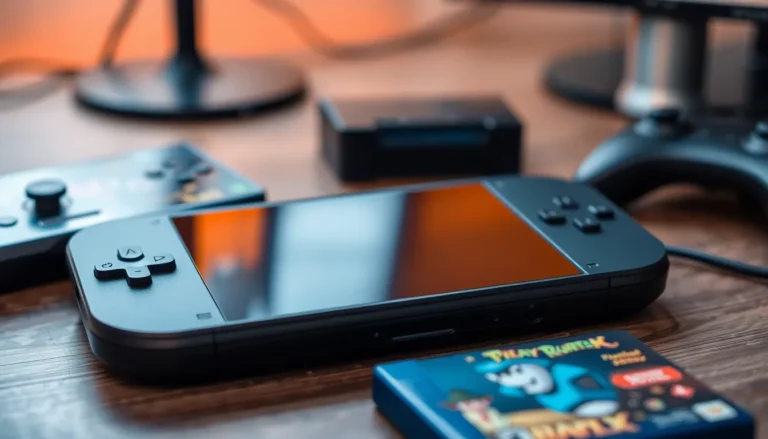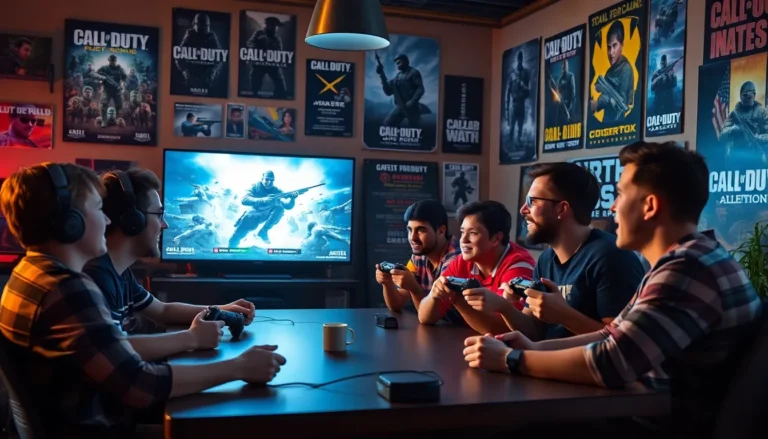Table of Contents
ToggleIn the fast-paced world of Valorant, every millisecond counts. Picture this: you’re locked in an epic showdown, your heart races, and suddenly—your frames per second (FPS) plummets faster than a rogue Phoenix ult. Low client FPS can turn even the most seasoned players into sitting ducks, leaving them wondering if they accidentally wandered into a slow-motion movie.
But fear not! Understanding why your FPS is lagging can be the first step toward reclaiming your in-game glory. From pesky background processes to outdated drivers, a few tweaks can have your game running smoother than a freshly polished Viper smoke. Dive into the nitty-gritty of FPS optimization and unleash your true gaming potential. After all, who wants to be the player who gets taken out by a glitch?
Understanding Low Client FPS in Valorant
Low client FPS in Valorant significantly affects gameplay. Players notice slower reaction times and poor movement, impacting their overall experience.
What Is FPS?
FPS stands for frames per second. This metric measures how many individual images a game displays in one second. Higher FPS results in smoother motion and better visual clarity. For competitive titles like Valorant, achieving a minimum of 60 FPS is crucial. Many players strive for 144 FPS or even higher for optimal performance. Understanding FPS helps players evaluate their in-game experience and identify potential issues.
Importance of FPS in Gameplay
FPS plays a critical role in gameplay quality. High FPS provides a competitive advantage in fast-paced environments. Players can react more quickly to in-game events, leading to better aim and movement precision. Low FPS often results in choppy visuals and delayed inputs, making it challenging to perform well. Maintaining a consistent FPS ensures smoother gameplay, allowing players to focus on strategy rather than technical problems. Ultimately, high FPS supports skill development and enhances the overall gaming experience.
Common Causes of Low Client FPS
Low client FPS in Valorant often stems from a variety of factors affecting performance. Addressing these issues can significantly improve gaming experience for players.
Hardware Limitations
Hardware limitations frequently cause low FPS issues. Inadequate CPU, underpowered GPU, or insufficient RAM may hinder performance. For instance, a CPU below 3.0 GHz can struggle with modern games, while 8GB of RAM serves as a bare minimum. Over time, older graphics cards may fail to meet newer game requirements. Replacing outdated components often yields noticeable FPS improvements. Ensuring hardware compatibility with game specifications becomes essential for better game performance.
Software Conflicts
Software conflicts pose another challenge for players experiencing low FPS. Background applications can consume valuable system resources, impacting overall performance. Programs such as web browsers, game launchers, and even antivirus software may interfere. Disabling unnecessary programs before launching Valorant often helps enhance FPS. Additionally, outdated drivers can cause compatibility issues, so regularly updating GPU drivers ensures optimal performance. Running the game in clean boot mode eliminates potential conflicts to improve FPS significantly.
In-Game Settings
In-game settings significantly influence FPS performance. High graphical settings can burden system resources, leading to lower FPS. Reducing options like texture quality and shadow detail can boost performance. Lowering the resolution or adjusting aspect ratios often improves frame rates without sacrificing too much visual quality. Players should also disable V-Sync and motion blur for smoother gameplay. Experimenting with settings provides opportunities to find the right balance between visual fidelity and performance, enhancing the overall gaming experience.
Troubleshooting Low Client FPS
Low client FPS can hinder gameplay, impacting both reaction times and overall performance. Addressing this issue involves several key steps.
Updating Drivers
Updating drivers remains vital for optimal FPS in Valorant. Graphics drivers, in particular, directly influence performance. Players can download the latest versions from their GPU manufacturer’s website, such as NVIDIA or AMD. It’s also beneficial to install chipset updates, as they can enhance overall system stability and performance. Regularly checking for updates ensures the system takes advantage of performance fixes and improvements. Outdated drivers can cause compatibility issues, so keeping them current significantly boosts FPS.
Optimizing Game Settings
Optimizing game settings maximizes FPS in Valorant. Players should experiment with reducing graphical settings like shadows, anti-aliasing, and texture quality. Lowering the resolution can also lead to improved performance without sacrificing too much visual clarity. Turning off V-Sync can eliminate input lag and help achieve higher FPS. Creating custom configurations allows players to find the balance that works best for performance and visuals. Each adjustment contributes to a more responsive and smoother gaming experience.
Checking System Performance
Checking system performance ensures the hardware runs efficiently. Players can use task managers to monitor CPU, GPU, and RAM usage during gameplay. High resource usage indicates potential bottlenecks, suggesting a need for upgrades or optimizations. Closing unnecessary background applications also helps free up resources, enhancing performance. Ensuring that the system cooling is adequate prevents overheating, which can reduce FPS. Regular maintenance like disk cleanup and defragmentation can further improve overall performance.
Tips to Improve FPS in Valorant
Players can enhance their FPS in Valorant through various methods. Focusing on hardware upgrades, visual settings adjustments, and managing background applications presents significant opportunities for improvement.
Upgrading Hardware
Upgrading hardware can dramatically boost FPS. A modern CPU helps process game data more efficiently, resulting in smoother gameplay. Increasing RAM allows for better multitasking, which is essential when running demanding applications. Investing in a powerful GPU directly impacts graphical rendering, ensuring higher frame rates. Players often achieve noticeable improvements by replacing outdated components with newer models. For example, switching from a standard HDD to an SSD can significantly reduce load times, enhancing overall performance within the game.
Adjusting Visual Settings
Adjusting visual settings provides a quick way to improve FPS. Lowering the graphical quality reduces the demand on hardware, leading to increased frame rates. Disabling features like anti-aliasing or shadows allows players to maintain visual clarity without compromising performance. Resolution adjustments can also create a balance between visuals and gameplay smoothness. Players commonly experiment with settings to find optimal configurations suited to their systems. Custom settings tailored to individual hardware capabilities enable smoother experiences while maintaining competitive gameplay.
Closing Background Applications
Closing background applications frees up system resources and enhances FPS. Many players overlook background processes that consume CPU and RAM, causing unnecessary slowdowns. Utilizing task managers helps identify which applications to shut down for optimal performance. Players often benefit from disabling programs that run during gameplay, such as browsers or music streaming services. Ensuring that only essential applications are active maximizes available resources. Regular monitoring of background activity keeps systems running efficiently, directly impacting gameplay experience.
Conclusion
Achieving optimal FPS in Valorant is vital for any player looking to enhance their gaming experience. By addressing common issues like hardware limitations and software conflicts players can significantly improve their performance. Simple adjustments such as updating drivers optimizing game settings and managing background processes can make a noticeable difference.
Investing in hardware upgrades and fine-tuning visual settings not only boosts FPS but also leads to smoother gameplay. With a focus on these strategies players can enjoy a more competitive edge and fully immerse themselves in the fast-paced world of Valorant. Prioritizing FPS will ultimately allow players to react swiftly and execute strategies effectively ensuring a more enjoyable gaming experience.






